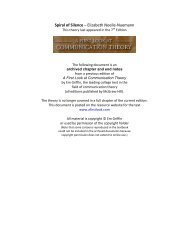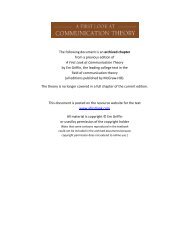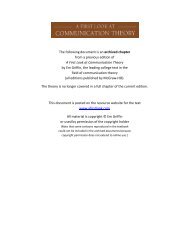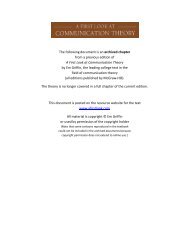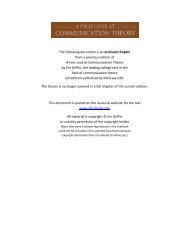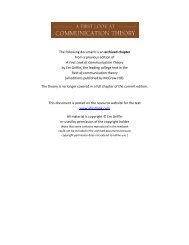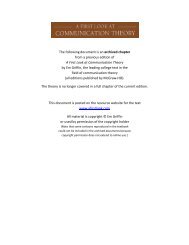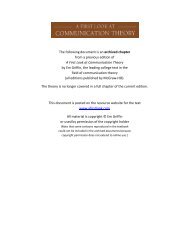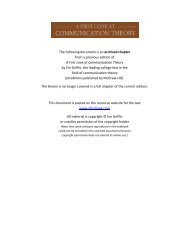Interpersonal Deception Theory (PDF) - A First Look at ...
Interpersonal Deception Theory (PDF) - A First Look at ...
Interpersonal Deception Theory (PDF) - A First Look at ...
- No tags were found...
You also want an ePaper? Increase the reach of your titles
YUMPU automatically turns print PDFs into web optimized ePapers that Google loves.
CH,1VfER 7: INTU\I'ERSONAf. LH~CEI)TION F1iEORY103Those who desire a clear-cut way to separ<strong>at</strong>e truth telling from deception mighthope th<strong>at</strong> these four telltale signs of str<strong>at</strong>egic messages would provide an either/ orlitmus test for discerning honesty. But the world of interpersonal communic<strong>at</strong>ion isnot th<strong>at</strong> simple. Almost all communic<strong>at</strong>ion is intentional, goal directed, and mindful.According to Proposition 3, deceptive communic<strong>at</strong>ion is simply more so.Five of Buller and Burgoon's propositions show th<strong>at</strong> multiple factors stronglyaffect the extent of a deceiver's str<strong>at</strong>egic behavior. They claim th<strong>at</strong> this plan-basedactivity increases when the situ<strong>at</strong>ion is highly interactive (Prop. 4), when the partiesknow each other well (Prop. 8), when the deceiver particularly fears discovery(Prop. 6), when the deceiver's motiv<strong>at</strong>ion is selfish (Prop. 7), and when the deceiverhas good communic<strong>at</strong>ion skills (Prop. 9). It's not a stretch to think th<strong>at</strong> allfive of these intensifying factors will come into play if you decide to conceal,equivoc<strong>at</strong>e, or falsify. If you do, your mind will be whirling.Buller and Burgoon firmly believe th<strong>at</strong> str<strong>at</strong>egic moves aid successful deception.Yet even with all the high-intensity cognitive effort you might bring to the encounter,there's no guarantee th<strong>at</strong> you'll pull it off. <strong>Interpersonal</strong> deception theorysuggests th<strong>at</strong> the outcome depends not only on the quality of your message butalso on the nonstr<strong>at</strong>egic cues you can't control.lEAKAGE: THE TRUTH WILL COME OUT (MAYBE)A century ago, psychi<strong>at</strong>ric pioneer Sigmund Freud st<strong>at</strong>ed the case for using nonverbalcues to detect deception. Referring to a p<strong>at</strong>ient who wouldn't be truthfulabout his darkest thoughts and feelings, Freud observed, "If his lips are silent, hech<strong>at</strong>ters with his fingertips; betrayal oozes out of him <strong>at</strong> every pore." 11 Buller andBurgoon agree th<strong>at</strong> behavior outside of the deceiver's conscious control can signaldishonesty, and they basically endorse the well-known four-factor model ofdeception developed by University of Rochester social psychologist Miron Zuckermanto explain why this leakage occurS. 12<strong>First</strong>, deceivers' intense <strong>at</strong>tempt to control inform<strong>at</strong>ion can produce performancesth<strong>at</strong> come across as too slick, or "canned." Nonstr<strong>at</strong>egic inform<strong>at</strong>ion leaksusually go hand-in-hand with str<strong>at</strong>egic activity. Second, lying causes physiologicalarousal. Th<strong>at</strong>'s why a polygraph, which measures only autonomic responses, iscalled a "lie detector." Third, the predominant felt emotions th<strong>at</strong> accompany deceitare guilt and anxiety. Although "duping delight" is always a possibility, most peoplefeel bad about lying and are likely to show it. Finally, the complex cognitive jl7Ctorsinvolved in deception can tax the brain beyond its capacity. Cognitive overloadmeans some behaviors go untended.In a st<strong>at</strong>istical procedure called meta-analysis, Zuckerman combined the resultsof 35 different leakage studies conducted by various researchers to see wh<strong>at</strong>unintentional nonverbal behaviors usually accompany deception. 13 Freud'sdrumming fingers made the list as part of a c<strong>at</strong>egory called "self adapters"-fidgetyhand movements unrel<strong>at</strong>ed to wh<strong>at</strong> is said. Other telltale signs were• Increased blinking and enlarged pupils• Frequent speech errors (gramm<strong>at</strong>ical mistakes, repetitions, slips of the tongue)



